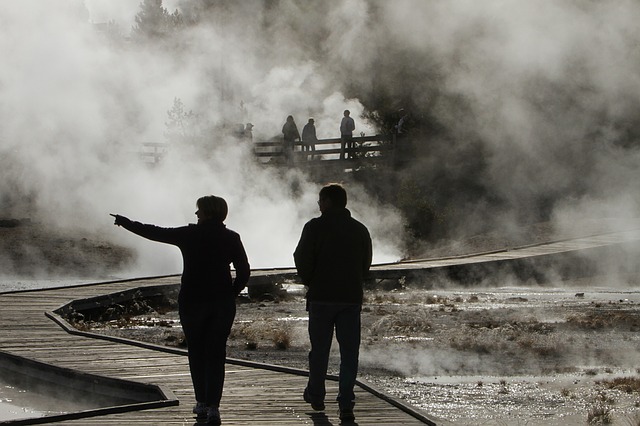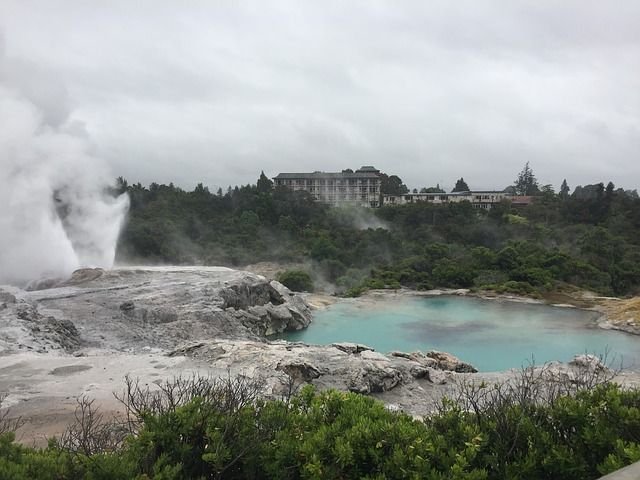How Does Geothermal Energy Work?

The word geothermal literally means heat from within the earth. At its simplest, geothermal energy is power extracted from heat within the earth’s crust. Very deep within the earth is a layer of molten rock known as magma, from which heat is continually produced through the natural decay of uranium, potassium and other radioactive materials. The layers of rock surrounding this magma are super-heated, gradually declining in temperature as you move farther from the molten core and toward the relatively chilly surface.
Erupting volcanoes are an example of magma exploding through chambers connected to this molten layer, usually by way of seismic activity. So it stands to reason that areas with high volcanic or seismic activity have the highest geothermal resources. Yet geothermal energy is everywhere. According to the Union of Concerned Scientists, the amount of heat within 33,000 feet of the earth’s surface contains 50,000 times more energy than all the oil and gas resources in the world.
Is Geothermal Energy Renewable?
Geothermal power is not inherently a renewable resource; a geothermal resource can be depleted. However, proper plant management can transform geothermal power into a renewable resource. The key is to avoid removing more super heated water than can be replenished by natural processes or through re-injection of used water resources.
New geothermal power plants are much more efficient than their predecessors, as plant operators have learned over the years of their depletion of geothermal resources. The nation’s largest plant in a region of northern California known as Geysers is a good example of what can happen if a resource isn’t cared for. That plant was producing 2,000 megawatts of electricity at its peak, but because of over-aggressive production, depleted much of its resource and now produces roughly 725 megawatts.
Ground-Source Heat Pumps for Residential Use
On a smaller scale, geothermal power is used by thousands of homes across America for heating and cooling. These systems take advantage of the consistent temperatures in the very top layer of the earth’s crust, but below the frost line. At about 5-10 feet deep, the temperature of the earth’s surfaces stays consistent at about 50 degrees year round, even in cold northern climates.
In the summer, ground source heat pumps send warm indoor air through a network of pipes or tubes buried in the yard. The air cools as it passes through the underground tubing and is recirculated into the home as air conditioning.
In the winter, the heat pumps act as a go-between for the home and the conventional heating system. The geothermal system sends cold outside air through the warmer tubes underground before passing it on to the conventional heater as pre-heated air.
According to the EPA, ground source heat pumps are as much as 72 percent more efficient than electric heating and air conditioning, which is important as geothermal heat pumps are catching on fastest in rural areas, where natural gas lines do not reach and residents must use electric heating.
How to Find Geothermal Energy
Volcanoes and high geothermal resources are both symptoms of the same natural phenomena: plate tectonics. Geothermal resources are best where heat has an easy path to the surface. The easiest paths lie along plate edges, especially around active volcanoes. The Pacific Rim, running through California, Oregon and up to Alaska, is a prime example.
Along these areas, water seeps into the hot rock naturally, heats up and is expelled as steam. There is energy in that steam, energy which has been harvested for many decades. Geysers such as Old Faithful at Yellowstone National Park or any hot springs you may have visited are examples of geothermal power in its natural state.
How to Collect Geothermal Energy
Geothermal is considered a renewable resource because it derives from an unending heat source (similar to solar energy but from inner space rather than outer space), and involves water which is replenished by rainfall. At their simplest, geothermal power plants simply tap into hydrothermal convection systems, or that steam rising from the earth’s crust.
There are, in fact, three ways to harvest geothermal resources at present.
Collection Method #1 – Dry Steam System
The first is the simplest: capture the steam naturally emitting from the earth and use it to drive a turbine to create electricity. Called a dry steam system, these plants drill a hole into the heated rock. Then, a vacuum is formed to draw the steam naturally created near the surface through the turbine to create power. The excess steam passes through a condenser, where it reconstitutes as water and is sent back into the ground.
The well used to extract super-heated water from the earth is called a production well, while the pump used to return condensed or excess fluid is called an injection well.
Collection Method #2 – Flash Steam Power Plant
The second system is called a Flash Steam power plant. If water within the rock is at a high enough temperature, it is pumped to the surface as water, where it is depressurized, or “flashed,” into steam to drive the turbine.
Collection Method #3 – Binary (Closed-Loop) System
Here is where the future of geothermal power lies. In this Binary or closed-loop system, the water from within the rocks never sees the light of day. It is heated within the crust and pumped up to the surface through a heat exchanger, where it passes its heat onto a second fluid. This fluid will have a lower boiling point than water and is therefore easier to create steam with, thus making the entire process more efficient. Once the water has cooled by transferring its heat, it is recycled back into the ground.
The binary system solves a key problem for geothermal power. Open-loop geothermal plants emit some toxic substances, such as sulphur dioxide, that naturally exist in the water and rocks deep in the earth’s crust. Steam that is lost as waste heat contains these particles. However, a closed-loop system takes care of that. Everything pumped up to the surface goes directly back down.
Hot Dry Rock
In some areas, the rocks are plenty hot enough, but water doesn’t flow through them and back to the surface. So scientists came up with a method of “wetting” down these rocks to increase the geothermal potential. In a
Hot Dry Rock scenario, rocks are broken up by pumping super high-pressure water into them. Then, cool water is circulated through the broken rocks, where it can be heated and used to create steam in one of the three methods described above.
Engineered Geothermal Systems (EGS)
Geothermal energy is everywhere, but it’s easier to get to in some places than others. The United States is a world leader in geothermal energy, although it makes up a very small percent of our energy consumption, but most of our potential is in the West and Southwest, where seismic activity is prevalent.
Moving eastward from the western coast, geothermal resources tend to decrease, despite a few pockets here and there around southeast Texas and the Northeast. New technology, however, is challenging the idea that geothermal resources aren’t available in less seismically active regions. The hot internal rocks are there – they’re just harder to get to.
So engineers have come up with Engineered Geothermal Systems. These systems simply drill deeper holes to create geothermal resources where they otherwise may not exist. These holes are typically a mile or more deep. Once the hole is drilled, water is circulated through it to create steam for a binary geothermal plant.
EGS is a fairly new technology, but is getting attention from both public and private investors. Drilling a hole a mile or two into the earth’s crust is not a simple task, and it’s bound to wear down a few drill bits. One solution has been to abandon conventional steel drill bits for super-heated water.
Sources:
- Union of concerned scientists: How geothermal energy works
- US Department of Energy: Calpine: America’s largest geothermal energy producer
- United States Environmental Protection Agency: Geothermal Heating and Cooling Technologies
- Science Direct: Enhanced Geothermal Systems: A review

This was a very informative article, thanks for writing it!
Thank you for reading it :)